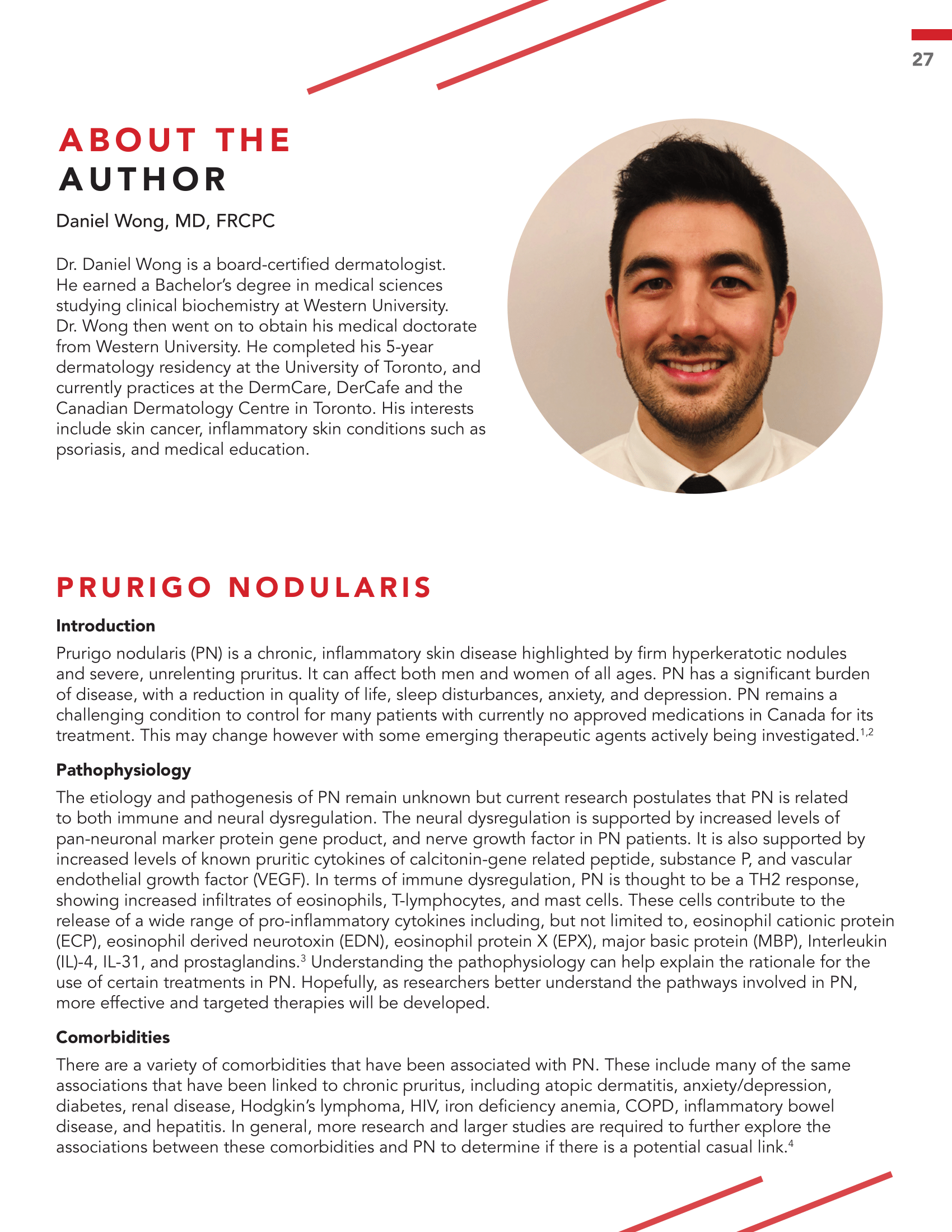Prurigo Nodularis
Abstract
Prurigo nodularis (PN) is a chronic, inflammatory skin disease highlighted by firm hyperkeratotic nodules and severe, unrelenting pruritus. It can affect both men and women of all ages. PN has a significant burden of disease, with a reduction in quality of life, sleep disturbances, anxiety, and depression. PN remains a challenging condition to control for many patients with currently no approved medications in Canada for its treatment. This may change however with some emerging therapeutic agents actively being investigated.
References
Huang AH, Canner JK, Khanna R, Kang S, Kwatra SG. Real-World Prevalence of Prurigo Nodularis and Burden of Associated Diseases. J Invest Dermatol. 2020 Feb;140(2):480-483.
Pereira MP, Hoffmann V, Weisshaar E, et al. Chronic nodular prurigo: clinical profile and burden. A European cross-sectional study. J Eur Acad Dermatol Venereol. 2020 Oct;34(10):2373-2383.
Williams KA, Huang AH, Betzberg M, Kwatra SG. Prurigo nodularis: Pathogenesis and management. J Am Acad Dermatol. 2020 Dec;83(6):1567-1575.
Huang AH, Williams KA, Kwatra SG. Prurigo nodularis: Epidemiology and clinical features. J Am Acad Dermatol. 2020 Dec;83(6):1559-1565.
Bolognia J, Schaffer JV, Cerroni L. Dermatology Fourth Edition. 2017 Oct;Section 2:115
Goldsmith LA, Katz SI, Gilchrest BA, Paller AS, Leffell DJ, Wolff K. Fitzpatrick’s Dermatology in General Medicine Eighth Edition. 2012; Section 4:186.
Willams KA, Roh YS, Brown I, Sutaria N, Bakhshi P, Choi J, Gabriel S, Chavda R, Kwatra SG Pathophysiology, diagnosis and pharmacological treatment of prurigo nodularis. Expert Rev Clin Pharmacol. 2021 Jan;14(1):67-77.
Qureshi AA, Abate LE, Yosipovitch G, Friedman AJ. A Systematic Review of Evidence-Based Treatments for Prurigo Nodularis. J Am Acad Dermatol. 2019 Mar;80(3):756-764.
Saraceno R, Chiricozzi A, Nisticò SP, et al. An occlusive dressing containing betamethasone valerate 0.1% for the treatment of prurigo nodularis. J Dermatolog Treat. 2010 Nov;21(6):363-6.
Siepmann D, Lotts T, Blome C, et al. Evaluation of the antipruritic effects of topical pimecrolimus in non-atopic prurigo nodularis: Results of a randomized, hydrocortisone controlled, double-blind phase II trial. Dermatology. 2014;227(4):353-360.
Ständer S, Luger T, Metze D. Treatment of prurigo nodularis with topical capsaicin. J Am Acad Dermatol. 2001;44(3):471-478.
Huang AH, Canner JK, Kang S, et al. Analysis of real-world treatment patterns in patients with prurigo nodularis. J Am Acad Dermatol. 2020 Jan;82(1):34-36.
Stoll DM, Fields JP, King LE. Treatment of Prurigo Nodularis: Use of cryosurgery and intralesional steroids plus lidocaine. J Derm Surg Onc. 1983;9(11):922-924.
Wong SS, Goh CL. Double-blind, right/ left comparison of calcipotriol ointment and betamethasone ointment in the treatment of prurigo nodularis. Arch Dermatol. 2000;136:807-808.
Hann SK, Cho MY, Park YK. UV treatment of generalized prurigo nodularis. Int J Dermatol. 1990 Jul-Aug;29(6):436-7.
Rombold S, Lobisch K, Katzer K, Grazziotin TC, Ring J, Eberlein B. Efficacy of UVA1 phototherapy in 230 patients with various skin diseases. Photodermatology, Photoimmunology & Photomedicine. 2008;24(1):19–23.
Brenninkmeijer EEA, Spuls PI, Lindeboom R, Van Der Wal AC, Bos JD, Wolkerstorfer A. Excimer laser vs clobetasol propionate 0.05% ointment in prurigo form of atopic dermatitis: a randomized controlled trial, a pilot. Br J Dermatol. 2010;163:823-831.
Andersen TP, Fogh K. Thalidomide in 42 patients with prurigo nodularis hyde. Dermatology. 2011;223:107-112.
Sharma D, Kwatra SG. Thalidomide for the treatment of chronic refractory pruritus. J Am Acad Dermatol. 2016;74:363-369.
Spring P, Gschwind I, Gilliet M. Prurigo nodularis: retrospective study of 13 cases managed with methotrexate. Clin Exp Dermatol. 2014;39:468-473.
Klejtman T, Beylot-Barry M, Joly P, et al. Treatment of prurigo with methotrexate: a multicentre retrospective study of 39 cases. J Eur Acad Dermatol Venereol. 2018;32:437-440.
Siepmann D, Luger TA, Stander S. Antipruritic effect of cyclosporine microemulsion in prurigo nodularis: results of a case series. J Dtsch Dermatol Ges. 2008;6:941-946.
Wiznia LE, Callahan SW, Cohen DE, Orlow SJ. Rapid improvement of prurigo nodularis with cyclosporine treatment. J Am Acad Dermatol. 2018;78:1209-1211.
Mazza M, Guerriero G, Marano G, Janiri L, Bria P, Mazza S. Treatment of prurigo nodularis with pregabalin. J Clin Pharm Ther. 2013;38:16-18.
Gencoglan G, Inanir I, Gunduz K. Treatment of prurigo nodularis and lichen simplex chronicus with gabapentin. Derm Therap. 2010;23(2):194-198.
Zalaudek I, Petrillo G, Baldassarre MA, et al. Amitriptyline as therapeutic and not symptomatic approach in the treatment of prurigo nodularis: a pilot study. G Ital Dermatol Venereol. 2006;141:433-437.
Stander S, Bockenholt B, Schurmeyer- Horst F, et al. Treatment of chronic pruritus with the selective serotonin re-uptake inhibitors paroxetine and fluvoxamine: results of an open-labelled, two-arm proof-of-concept study. Acta Derm Venereol. 2009;89:45-51.
Jaller J, Yosipovitch G. Successful treatment of epidermal nevus-associated pruritus with topical ketamineeamitriptylinee lidocaine. Acta Derm Venereol. 2018;98:121-122.
Stander S, Kwon P, Luger T. A randomized, double-blind, placebo-controlled, study of the neurokinin-1 receptor (nk1-r) antagonist serlopitant in subjects with prurigo nodularis (PN). Paper presented at: American Academy of Dermatology Annual Meeting. 2017 March 3-7.
Maredia H, Kwatra SG. Emerging novel therapeutic agents for the treatment of patients with prurigo nodularis. J Dermatolog Treat. 2020 Jan;3;1-4.
Stander S, Yosipovitch G, Legat FJ, Lacour JP, Paul C, Narbutt J, et al. Trial of Nemolizumab in Moderate-to-Severe Prurigo Nodularis. N Engl J Med. 2020 Feb;382(8):706-716.
Stander S, Reinhardt HW, Luger TA. Topical cannabinoid agonists: an effective new possibility for treating chronic pruritus. Der Hautarzt. 2006;57:801–807.
Park B. Nemolizumab Gets Breakthrough Therapy Status for Prurigo Nodularis empr.com2019 [updated December 9; cited 2021, Aug 25]. Available from: https://www.empr.com/home/news/nemolizumab-gets-breakthrough-therapy-status-forprurigo-nodularis.


